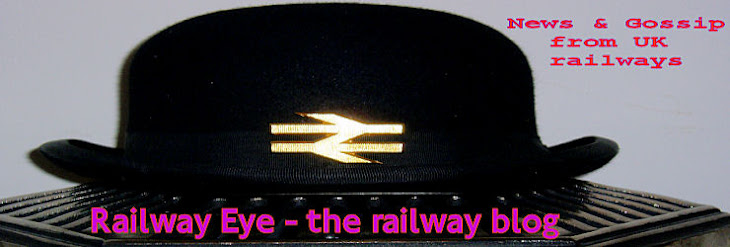Those of you unconvinced of the benefits of Twitter may soon be converted.
Those canny boys and girls over at Chiltern are "offering Twitter followers the perfect gift for Father’s Day – a train cab ride on our infamous bubble car."
The Fact Compiler, whilst not convinced that a bubble car can be 'infamous', has already entered!
UPDATE: This, unbelievably, 'twittered' to The Fact Compiler by a very slick Chiltern...
We used the word "infamous" with a sense of irony.
This is an amazing prize for one lucky dad.
We all love the bubble car!
Good effort - nice use of technology.
Tuesday, 16 June 2009
Chiltern blows bubbles on Twitter
Guest Post: Railways and social media #2
Monday's guest post from Ben Smith on how the railways might use social media attracted considerable interest amongst readers.
Brendan Nelson, a consultant who works for Tobias & Tobias, helped FCC to deliver the Twitter service that Ben mentioned in his post.
Brendan has asked if he might share his view with Eye readers.
Yes he may and here it is:
A number of rail companies have already responded to Ben Smith's guest column on June 15th, which argued that rail companies are failing to exploit social media.
However, as one of those behind the First Capital Connect Twitter service Ben singled out as "getting it wrong", I thought I'd chip in with my own two cents.
Twitter users subscribe to, or "follow", any number of other Twitter accounts. The more accounts a user "follows", the more information they receive - and the more difficult it becomes to sift through the incoming stream of information.This information overload poses a challenge to train operators looking to use Twitter. They generate a lot of data, most of which the average customer will find irrelevant. For example, customers travelling between Brighton and London Bridge at 6pm aren't interested in incidents at Stevenage close to midnight.
So if all this data is simply piped through a Twitter feed, its "followers" will have to deal with a high noise-to-signal ratio: the vast majority of messages will be of no relevance. This issue of relevance was the problem we set out to solve with FCC's Twitter service.
Our users state their journey preferences so that the system can send alerts when - and only when - relevant incidents occur. This is the fundamental difference between @FirstCC and @uktrains, which adopts more of a broadcast model. Followers of @uktr_firstcc might receive at least nine irrelevant messages for each relevant one.
Another strength of the "targeted" model is that our system uses Twitter's "direct message" feature, which means users receive emails and potentially SMS messages when alerts are sent. All this is free of charge.
Ben says that we miss the "social" aspect of Twitter. But I feel the social aspect is intrinsic to Twitter itself and users will forward on information that they feel is important - even if it came to them as an official, targeted communication. And a quick look at conversations on Twitter confirms that passengers don't need encouragement to talk about train services.
So while @uktrains has its strengths, I believe that - by solving the problem of relevance - our model does as well.
Just as bulletin boards didn't make email obsolete, the public conversations taking place on Twitter won't make official, targeted communications obsolete either.
ATOC tramples roughshod over heritage line
Oh dear.
ATOC's exciting Connecting Communities Report already appears to be falling apart under public scrutiny.
Readers will recollect that the report was widely leaked over the weekend before being officially unveiled on Monday to much media fanfare and misty eyed recollections of pre-Beeching days.
But it would appear that much of its thinking is back of the fag packet stuff, judging by this story in the Herald Express...
THE steam railway company which runs Churston Station says it has not been consulted over new plans to reconnect the line with the mainline route to Newton Abbot.
Andrew Pooley, general manager of Paignton and Dartmouth Steam Railway, says the company has not been involved in compiling the report, which singles out the old Brixham line as one of 14 which should be reopened nationwide.
And he says the idea 'has not been thought through'.
Indeed.
Perhaps surprising that ATOC didn't bother consulting with the heritage line before publishing a report that proposes using its infrastructure for new services.
Doubly so, as the report was written by the former chairman of another heritage railway in the South West.
Is the Eye alone in fearing that ATOC is now more interested in spin than substance?
GC introduces 12,000hp on ECML?
Exciting news from The Reporter, the Ciras newsletter.
Following a reader concern about the length of some Grand Central HST sets The Reporter sagely announces:  This presumably explains Grand Central's much improved reliability in recent months?
This presumably explains Grand Central's much improved reliability in recent months?
Nexus "not being privatised".
One of the bidders for the Tyne & Wear Metro may be about to drop out according to NEBusiness:
Last night The Journal was informed of rumours one bidder was preparing to pull out of the bidding process, a claim Nexus said it could not comment on.
There are currently four bidders for the Tyne & Wear metro concession: Deutsche-Bahn, Serco-Ned Rail, MTR Corporation and an in-house Nexus team.
Tyne Bridge MP David Clelland, who as a member of the transport select committee should know better, claimed that Nexus "...is not being privatised".
Which means that he is either deluded or that the smart money is on the in-house team.






